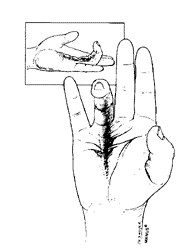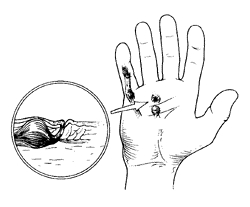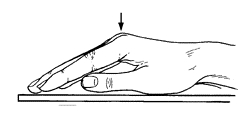Home | Education | Hand Conditions | Dupuytren Contracture Disease
Some people may develop a more severe form of Dupuytren's disease. These may be people who:
Dr. Smith provides a comprehensive multidisciplinary approach for the evaluation, treatment and care of Dupuytren’s.
Call Dr. Smith at 713-524-0580 for more information or to schedule an appointment concerning Dupuytren’s Contracture Disease.
The information on this webpage is based on material from the American Society for Surgery of the Hand and is for educational purposes only.
Dupuytren's Contracture Disease and Treatment
By Houston Hand Surgery Specialist & Orthopaedic Surgeon, Dr. Dean Smith
Dupuytren’s contracture is an abnormal thickening of the fascia (the tissue between the skin and the tendons in the palm) that may limit movement of one or more fingers. In some patients, a cord forms beneath the skin that stretches from the palm into the fingers. The cord can cause the fingers to bend into the palm so they cannot be fully straightened (see Diagram 1). Sometimes, the disease will cause thickening over the knuckles of the finger. Dupuytren’s can also occur in the soles of the feet.Causes of Dupuytren's Contracture
The cause of Dupuytren’s is unknown, and there is no permanent cure. The disease is usually painless. This is a non-cancerous condition. Dupuytren’s contracture mostly affects individuals with ancestors from Northern Europe. It occurs more often in men than in women and usually starts after age 40. In many cases, the disease runs in families.Some people may develop a more severe form of Dupuytren's disease. These may be people who:
- Develop the disease at a young age
- Have the disease in areas other than the hand
How Dupuytren's Contracture Develops
Dupuytren’s most often begins in the palm of the hand at the base of the ring or little fingers. A lump or pit may show up months, or even years, before a cord develops from the palm to the fingers. Drawing of the fingers into the hand can occur because of contracture of the fascia near the joints in the fingers. The skin may be involved with the disease, but the tendons in the hand are not affected. Having the disease in both hands is common.Dupuytren's Treatment
There is no permanent cure for Dupuytren’s disease. Available treatment options include collagenase injections (Xiaflex) or surgical treatment. Collagenase injections can rupture and dissolve the cord and provide some relief without having to undergo surgery. Surgery can relieve the contracture through excision and/or release of the cords. With either method of treatment, the condition can return with time. The goal of surgery for Dupuytren’s disease is to restore the use of the fingers. Dr. Smith will advise you on whether surgery or collagenase is recommended in your case.Dr. Smith provides a comprehensive multidisciplinary approach for the evaluation, treatment and care of Dupuytren’s.
 |
 |
 |
| Diagram 1: In serious cases of Dupuytren’s disease, a cord forms beneath the skin that prevents the affected finger from being fully straightened. | Diagram 2: Dupuytren’s disease usually shows up as a small lump or pit in the palm of the hand. | Diagram 3: Dupuytren’s disease is usually noticed when the palm cannot be placed flat on an even surface. |
Call Dr. Smith at 713-524-0580 for more information or to schedule an appointment concerning Dupuytren’s Contracture Disease.